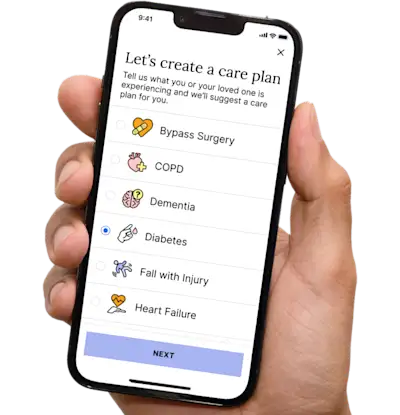How Does Diabetes Increase Risk of Infection?
Infections and infectious diseases are more frequent and often more serious in persons with diabetes.
Get insurance benefits, legal documents, and medical records in one place

Helpful Highlights
Persons with diabetes are more susceptible to infections for several reasons.
Infections in persons with diabetes are more difficult to treat.
Caregiver recommendations specific to each diabetes-related risk factor are included.
The number of risk factors for infection increases with diabetes. Persons with diabetes experience unique physiological effects that make them more susceptible to infections. These effects also reduce their ability to fight them.
Neuropathy and reduced blood flow
Especially in those who have had diabetes for a long time, nerve damage and reduced blood flow to their lower legs, feet, and hands are common. This increases the chance of infection because of poor tissue health in those areas.
Natural barriers (skin and mucosal membranes) are broken
Muscles and connective tissues are weaker
Vessels have limited ability to deliver adequate oxygen, nutrients, and fighter cells to where they are most needed
This also results in low concentrations of antibiotic medications delivered to the infected tissues
What you can do: Daily skin checks, lots of massaging and moisturizing, encourage hydration (preferably water), and get your loved one active.
High blood sugar levels
A high level of sugar circulating in the blood (hyperglycemia) contributes to infection in a few ways.
It serves as a food supply for invading organisms, allowing bacteria and viruses to grow and multiply rapidly and infections to develop quickly.
It also causes problems with immune response, so the cells programmed to seek and destroy pathogens (disease-causing organisms) fail to control the spread of those pathogens.
It damages blood vessels and limits their ability to transport necessary oxygen, nutrients, and immune cells to the areas where they're needed.
It damages cells and tissues in systems that are essential for overall physiological stability and health, such as the brain and kidneys.
What you can do: Ensure regular blood sugar checks, plan diabetes-friendly grocery lists and meal prep, help with medication adherence, and get your loved one active.
Immune response dysfunction
There are several ways that diabetes impairs a person's defense against pathogens. (These are in no particular order.)
Suppression of cytokine production - proteins that signal the need for immune response aren't produced
Leukocyte recruitment inhibition - fighter cells aren't called to action
Defects in pathogen recognition - the invaders aren't identified
Neutrophil dysfunction - the traps for capturing and destroying the invaders aren't set
Defects in phagocytosis - if invaders are captured, they're not destroyed (eaten)
Natural killer cell dysfunction - the fighter cells don't fight and fail to control the invasion
Complement effector inhibition - the supporting actors aren't given their cues or stage directions
Inhibition of antibodies - cells that are trained to recognize the invader (should it come back) don't form or aren't able to attach to immune cells
What you can do: Check that everyone performs routine hand hygiene, keep actively ill people away, and ensure your loved one gets the necessary vitamins and nutrients to support their immune system.
Reduced sensation and delayed healing
Persons with diabetes are at high risk for problems in their lower legs and feet (you may still hear the old term, "diabetic foot"). Nerve tingling or pain and possibly numbness - called neuropathy - of the lower legs and feet greatly contribute to the risk of infection.
For persons who do not have intact sensation in these areas, they cannot feel repeated trauma like bumping, scraping, cutting, puncturing, and burning. Likewise, they may not be able to tell that their shoes are ill-fitting and causing skin tears and blistering.
Because diabetes also slows the healing process due to poor circulation and lack of immune cells, wounds may remain for extended periods, and even get worse before they start to get better.
The longer a wound persists, the more opportunity organisms have to cause infection. If these wounds, or the resulting infections, aren't treated promptly and properly, it could result in the need to amputate.
What you can do: Routine lower leg and foot checks, discourage walking barefoot, remind your loved one to check water temps with their wrist or elbow - not hands or feet, ensure proper fitting footwear (get diabetes-specific footwear, if needed), and request a referral to podiatry for foot concerns.
The most common infections in persons with diabetes
Although persons with diabetes are at higher risk for all infections, some have been identified as occurring most frequently in this population.
Ear, nose, and throat
Respiratory tract
Skin and soft tissue (including wound)
Urinary tract
Infection prevention
Because infections are difficult to control and resolve in persons with diabetes, and treatment outcomes are generally poorer, we must work diligently to prevent infection altogether.
Infection prevention in persons with diabetes requires the same efforts as with any other person, with a couple of essential additions.
BASIC
Always frequent and thorough hand washing... Everyone!
Get all recommended vaccinations
No contact with people who are sick
If your loved one must work with a caregiver who is sick, both should wear masks and have minimal close contact
Avoid crowds whenever possible
Eat right and stay well-hydrated
Get active every day
Take all medications as prescribed, every day, on time
ADDITIONS FOR DIABETES
Wear clean socks every day, along with supportive, soft, and full-coverage footwear
Wear gloves when cleaning and working
Conduct regular blood sugar checks (or continuous glucose monitoring)
Conduct daily skin checks
Seek medical care at the first hint of illness or injury
Persons with diabetes can be more severely affected by "common" infections
RESOURCES
Association for Professionals in Infection Control and Epidemiology (APIC)
Berbudi, A., Rahmadika, N., Tjahjadi, A.I., & Ruslami, R., (2020). Type 2 diabetes and its impact on the immune system. Current Diabetes Reviews, 16(5), 442-449. doi: 10.2174/1573399815666191024085838
Casqueiro, J., Casqueiro, J., & Alves, C. (2012). Infections in patients with diabetes mellitus: A review of pathogenesis. Indian Journal of Endocrinology and Metabolism, 16(Suppl1), S27-S36. doi: 10.4103/2230-8210.94253
Jin Kim, E., Hwa Ha, K., Jung Kim, D., & Hwa Choi, Y. (2019). Diabetes and the risk of infection: A national cohort study. Diabetes and Metabolism Journal, 43(6), 804-814. doi: 10.4093/dmj.2019.0071
Reynolds, S. (2020, September 29). Poor immune response impairs diabetic wound healing. NIH Research Matters. Retrieved from: https://www.nih.gov/news-events/nih-research-matters/poor-immune-response-impairs-diabetic-wound-healing
No content in this app, regardless of date, should ever be used as a substitute for direct medical advice from your doctor or other qualified clinician.
Get more support and guidance on insurance benefits, medical records and legal forms.
Helpful brings together your insurance benefits, legal documents, and medical records in one personalized place — so you always know what you have, and never have to search again.

Technology for Health Tasks. Mental Health for the Tough Stuff.
Helpful connects your medical records, insurance, and caregiving tasks automatically. And when you need more than logistics, a therapist is here to guide you.
In-Network and Covered
For Individuals, Couples and Families
HIPAA Compliant, Data Stays Private


Healthcare Tasks Simplified

From syncing records to spotting drug interactions, Helpful does the heavy lifting, turning complex health info into clear tasks and showing you benefits you can actually use, giving you clarity and control over your care.

In-Network Mental Health

Our licensed therapists are here to support you and your loved ones through stress, burnout, and life’s hardest moments, with an inclusive, compassionate approach that works with most insurance plans.

Create Legal Documents

Plan ahead by creating will, trusts, advance directives and more, that ensure your wishes are honored in the event you can’t speak for yourself -with Helpful guiding you every step of the way.